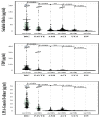Plasma Soluble Fibrin Is Useful for the Diagnosis of Thrombotic Diseases
- PMID: 37048680
- PMCID: PMC10095172
- DOI: 10.3390/jcm12072597
Plasma Soluble Fibrin Is Useful for the Diagnosis of Thrombotic Diseases
Abstract
Background: Soluble fibrin (SF) is a form of fibrinogen that is activated by thrombin and is considered to be useful for the diagnosis of the prethrombotic state or thrombosis.
Methods: Plasma levels of fibrin-related markers (FRMs), such as SF, D-dimer, fibrinogen, and fibrin degradation prioduct (FDP) levels in critically ill patients, were examined for the diagnosis of disseminated intravascular coagulation (DIC), venous thromboembolism (VTE), peripheral arterial thromboembolism (PATE), acute myocardial infarction (AMI), and acute cerebral infarction (ACI).
Results: FRMs showed the usefulness in diagnosing DIC and VTE and the cutoff values of D-dimer, FDP, and SF for DIC were 7.2-7.8 μg/mL, 10.0 μg/mL, and 9.5 μg/mL, respectively. The cutoff values of D-dimer and FDP for VTE were similar to the 97.5th percentile values of healthy volunteers, while the cutoff value of SF was 6.9 μg/mL. In AMI and ACI, the cutoff values of D-dimer and FDP were lower than the 97.5 percentile values of healthy volunteers. A receiver operating characteristic analysis for all thrombosis cases showed that an adequate cutoff value in only SF among FRMs was higher than the confidence interval of healthy volunteers. Only SF had high sensitivity for thrombosis, as the FDP/SF ratio was markedly low for ACI, AMI and VTE.
Conclusions: FRMs, especially D-dimer and FDP, were useful for diagnosing thrombosis with hyperfibrinolysis (e.g., DIC). As SF showed high sensitivity for predominantly thrombotic diseases, including arterial thrombosis, such as ACI and AMI, a high SF value suggests the possibility of an association with thrombosis. Finally, SF is the most useful marker for raising suspicion of an association with thrombosis, especially arterial thrombosis.
Keywords: D-dimer; DIC; FDP; soluble fibrin (SF); thrombosis.
Conflict of interest statement
The measurement of SF and D-dimer levels was partially supported by LSI Medience. In the other points, the authors declare no conflict of interest.
Figures




Similar articles
-
Elevated levels of soluble fibrin in patients with venous thromboembolism.Int J Hematol. 2008 Nov;88(4):448-453. doi: 10.1007/s12185-008-0173-5. Epub 2008 Oct 4. Int J Hematol. 2008. PMID: 18836793 Clinical Trial.
-
[A novel molecular marker for thrombus formation and life prognosis--clinical usefulness of measurement of soluble fibrin monomer-fibrinogen complex (SF)].Rinsho Byori. 2004 Apr;52(4):355-61. Rinsho Byori. 2004. PMID: 15164605 Review. Japanese.
-
Fibrin-related markers for diagnosing acute-, subclinical-, and pre-venous thromboembolism in patients with major orthopedic surgery.Int J Hematol. 2016 May;103(5):560-6. doi: 10.1007/s12185-016-1954-x. Epub 2016 Feb 12. Int J Hematol. 2016. PMID: 26872909
-
D-dimer kit with a High FDP/D-Dimer Ratio is Useful for Diagnosing Thrombotic Diseases.Clin Appl Thromb Hemost. 2022 Jan-Dec;28:10760296211070584. doi: 10.1177/10760296211070584. Clin Appl Thromb Hemost. 2022. PMID: 34994210 Free PMC article.
-
Are fibrin-related markers useful for the diagnosis of thrombosis?Semin Thromb Hemost. 2008 Feb;34(1):33-8. doi: 10.1055/s-2008-1066021. Semin Thromb Hemost. 2008. PMID: 18393141 Review.
Cited by
-
Biomarkers of Hypercoagulability in COVID-19.J Clin Med. 2023 May 17;12(10):3525. doi: 10.3390/jcm12103525. J Clin Med. 2023. PMID: 37240631 Free PMC article.
-
Normal Soluble Fibrin Levels Suggest a Low Probability of Pulmonary Embolism in Patients with Deep Vein Thrombosis.Clin Appl Thromb Hemost. 2025 Jan-Dec;31:10760296251356209. doi: 10.1177/10760296251356209. Epub 2025 Jul 2. Clin Appl Thromb Hemost. 2025. PMID: 40605367 Free PMC article.
-
Reference Value Fibrin Monomer in Healthy Children: A Cross-Sectional Study.Clin Appl Thromb Hemost. 2024 Jan-Dec;30:10760296241247560. doi: 10.1177/10760296241247560. Clin Appl Thromb Hemost. 2024. PMID: 38656143 Free PMC article.
-
Prognostic nomogram for heat stroke patients based on rapidly accessible clinical indicators.Front Med (Lausanne). 2025 Jul 25;12:1603374. doi: 10.3389/fmed.2025.1603374. eCollection 2025. Front Med (Lausanne). 2025. PMID: 40786089 Free PMC article.
-
Analysis of the diagnostic role of fibrin-related markers in perioperative venous thromboembolism.Front Surg. 2025 May 20;12:1530576. doi: 10.3389/fsurg.2025.1530576. eCollection 2025. Front Surg. 2025. PMID: 40463620 Free PMC article.
References
-
- Thachil J., Lippi G., Favaloro E.J. D-Dimer Testing: Laboratory Aspects and Current Issues. Methods Mol. Biol. 2017;1646:91–104. - PubMed
-
- Ikeda N., Wada H., Ichikawa Y., Ezaki M., Tanaka M., Hiromori S., Shiraki K., Moritani I., Yamamoto A., Shimpo H., et al. D-dimer kit with a High FDP/D-Dimer Ratio is Useful for Diagnosing Thrombotic Diseases. Clin. Appl. Thromb. Hemost. 2022;28:10760296211070584. doi: 10.1177/10760296211070584. - DOI - PMC - PubMed
Grants and funding
LinkOut - more resources
Full Text Sources
Research Materials

